**Introduction **
The practice of machines to assimilate information via the paradigm of supervised learning algorithms has revolutionized several tasks like sequence generation, natural language processing and even computer vision. This approach is based on utilizing a dataset which has a set of input features and a corresponding set of labels. The machine then uses this information present in the form of features and labels to learn the distribution and patterns of the data to make statistical predictions on unseen inputs.
A paramount step in designing deep learning models is evaluating the model performance, especially on new and unseen data points. The key goal is to develop models that generalize beyond the data that they were trained on. We want models that can make good and reliable predictions in the real world. An important concept that helps us with this is model validation and regularization which we will cover today.
#artificial intelligence #deep learning #machine learning #model validation
